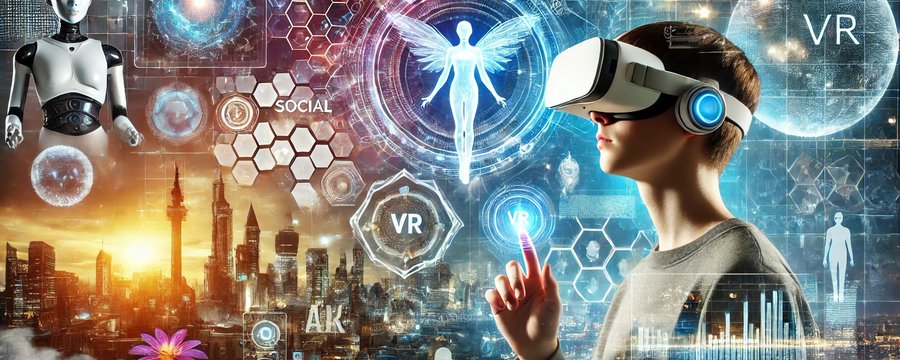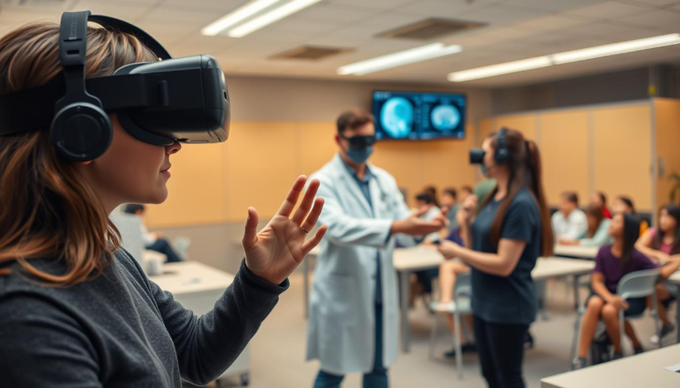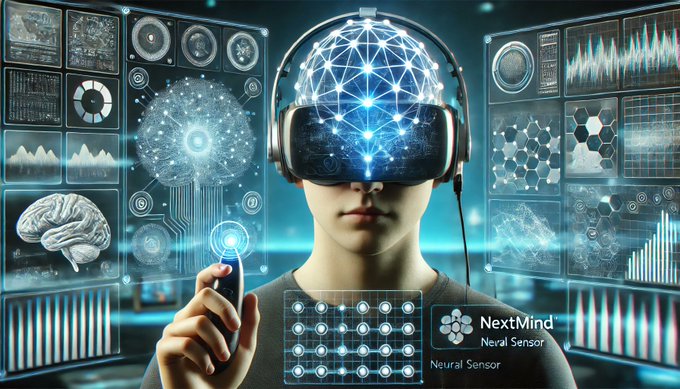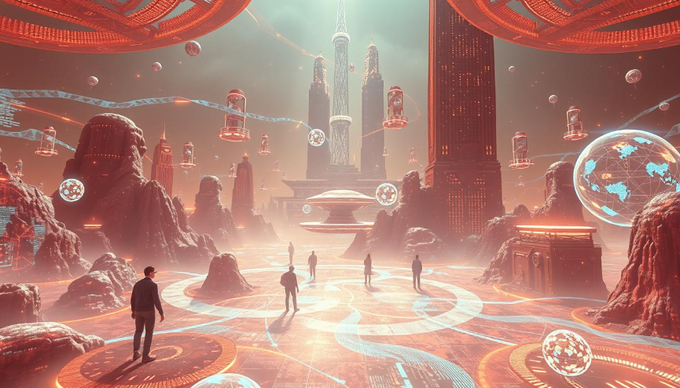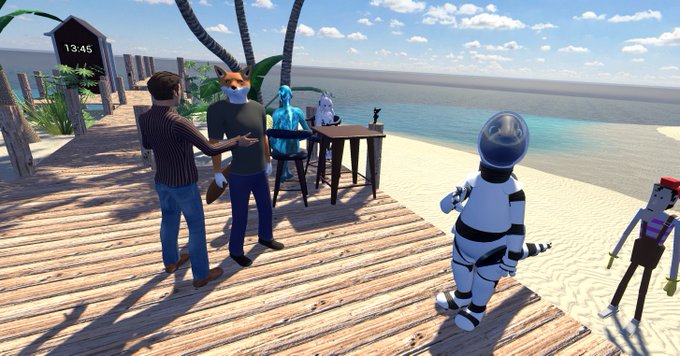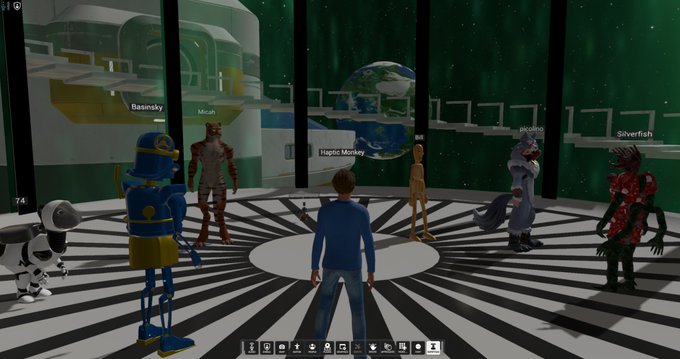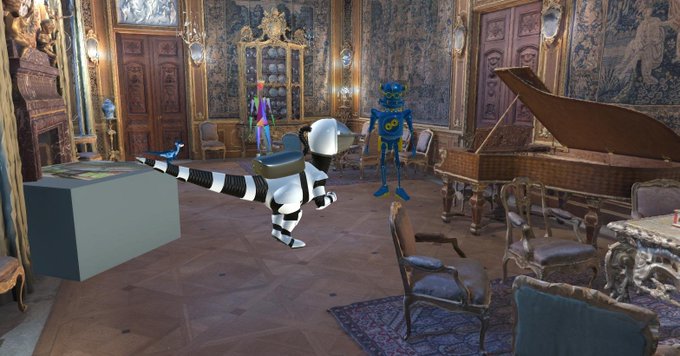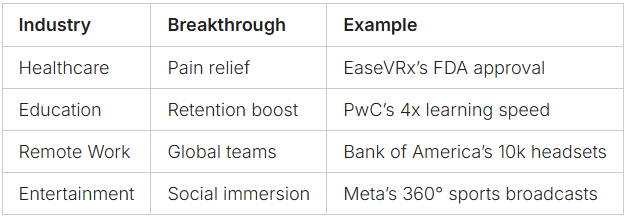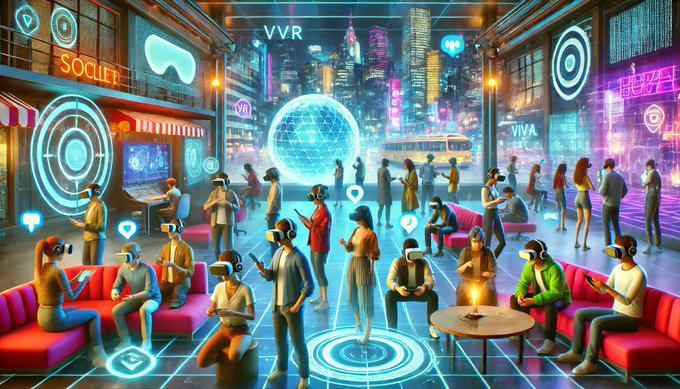The Future of VR: A Wild Ride Through Pixels and Possibilities
Hey there, tech explorers! Buckle up, because we’re diving headfirst into the mind-bending world of virtual reality (VR). It’s 2025, and VR isn’t just a clunky headset anymore. Picture a Veritasium explainer with Mark Rober’s knack for cool builds, sprinkled with Kurzgesagt’s big-picture flair and Linus Tech Tips’s tech-obsessed energy. Let’s unpack the current trends and peek into VR’s wild future with a mix of fun, facts, and a little bit of chaos.
I once stood on the edge of space in a VR experience. The wind roared, the Earth curved below me—my pulse spiked. That moment changed my view: VR went from “neat toy” to “mind-blowing tool.”
Back in the early days, headsets were bulky and often made me dizzy. Now, the global VR market’s booming, set to hit $57.55 billion by 2027. This isn’t just growth—it’s a seismic shift.
What changed? For one, my local school district now uses VR to teach anatomy. Students dissect 3D organs, not textbooks. Medical students train on virtual cadavers, slashing costs and errors.
Even my old doubts faded when I saw a teacher’s smile after her class retained 30% more info. Immersive technology isn’t just cool—it’s life changing.

Key Takeaways
- Virtual reality markets are exploding, hitting $57.55 billion by 2027 as tech evolves.
- OpenBCI’s Galea headset uses EEG and EDA sensors to track brainwaves and stress, merging health tech with VR.
- 71% of teachers say VR boosts learning, while 90% of phobia patients beat fears via VR exposure therapy.
- Apple’s Vision Pro and standalone headsets signal a shift toward sleek, accessible VR hardware.
- 90% success rates in VR therapy and 25% cost cuts in architecture prove this isn’t just hype—it’s real impact.
The Evolution of Virtual Reality: From Science Fiction to Digital Reality
Do you remember the first time you wore a VR headset? I did, and it was amazing. Back then, virtual reality was just a dream. The early VR headsets were clunky but showed us the way.
The Early Days: Clunky Headsets and Pixelated Dreams
Before we had high-quality displays, there were pioneers like Morton Heilig’s 1962 Sensorama. It mixed scent and motion for short stories. The term “virtual reality” was coined in 1987 by Jaron Lanier. But, early VR technology had slow displays and poor tracking.
My first try with the 1995 Virtual Boy? It gave me eye strain. But, these failures taught us valuable lessons.
The VR Renaissance: How Modern Tech Made It Real
- 2012: Oculus Rift’s $2.4M Kickstarter broke barriers
- 2016: HTC Vive brought room-scale tracking
- 2023: Meta Quest 3 hit 4k resolution per eye
Today, VR headsets like the Apple Vision Pro and Pico 4 Ultra are sleek and powerful. No more wires or nausea. Just clear, real landscapes.
When I tried the Quest 3S’s hand-tracking, I was amazed. We've come a long way from cardboard goggles.
Key Milestones That Shaped Today’s Landscape
Facebook’s $2B Oculus buy in 2014 made VR mainstream. 2020’s Beat Saber sold a million copies in months. Now, Meta Quest 3S and Apple’s spatial audio are pushing limits.
Every step, from Sutherland’s 1968 Sword of Damocles to today’s eye-tracking tech, brings us closer to perfect immersion.
Beyond Gaming: How VR Is Transforming Industries Today
When most people think of VR, they picture gamers in headsets. But VR applications are already changing industries far beyond play. Let me share what I’ve seen firsthand.
Take education: I watched a classroom in Chicago use immersive technology to send students back to ancient Egypt. Teachers report retention rates 75% higher than traditional lectures. Imagine holding a virtual artifact or watching a molecule bond—it’s no longer sci-fi.
Healthcare is another game-changer. Surgeons at Johns Hopkins now train on VR technology that mimics real operations, cutting mistakes by 30%. One burn unit uses VR to distract patients during wound care, slashing pain scores by 60%. “The immersive experience distracts better than drugs,” said Dr. Barbara Rothbaum, a VR therapy pioneer.
Here’s how industries are shifting:
Architects use VR to walk through buildings before they’re built. I toured a hospital design in VR with a construction team—they spotted safety issues months before construction began. Retail giants like Walmart train employees in VR, slashing onboarding time by 50%. And travel agencies let users explore Paris hotels from home, boosting bookings by 30%.
These aren’t just trends—they’re proof that VR’s potential is limitless. The numbers don’t lie: global VR market growth hit $15 billion in 2020 and keeps rising. This tech isn’t the future—it’s already here, reshaping how we learn, heal, and work.
Next-Generation VR Hardware: What's Coming to Your Face
Last year, I tried Apple’s Vision Pro and felt the future. Its $3,499 price might seem high, but the tech is worth it. The mixed reality display, controlled by finger gestures, showed a new level of VR technology.
Lightweight VR headsets are getting rid of cables and weight. The Meta Quest 3S has 8GB memory and 1,832x1,920 pixels. The Shiftall Meganex Superlight 8K is even lighter, at 185 grams.
Sony’s PlayStation VR2 shows 4K visuals at 120Hz. But soon, Qualcomm’s XR2+ Gen 2 chips will make devices like Samsung’s Project Moohan even better. They promise 4.3K per eye and 20% faster processing.
- Apple Vision Pro (4K micro-OLED, 120Hz)
- HTC Vive Pro 2 (4K per eye, 120Hz)
- Meta Quest 3 ($499, standalone 3K resolution)
Haptics are more than just buzzers now. I tried haptic gloves that let me feel a virtual sword’s weight. Full-body suits from Haptx turn virtual reality experiences into workouts.
Eye tracking is a big deal. The Vision Pro’s gaze controls menus faster than thumbsticks. Asus and Lenovo’s upcoming Meta-powered headsets will also have eye-tracking for $900+.
Pimax’s Dream Air is a game-changer. It has 4K OLED, weighs 200 grams, and ships this spring. The future is here, from $200 Quest 3S to $4,750 Sony SRH-S1. Next-gen hardware is faster and more invisible. The next two years will make today’s VR headsets seem old. Ready to upgrade? The future is on your face.
The Convergence of VR, AR, and XR: Creating Extended Reality Ecosystems
My hands hover over a virtual blueprint in augmented reality. Then, I snap into full virtual reality to work with engineers in a digital factory. This isn't science fiction—it's real. Devices like Apple’s Vision Pro and Meta’s Quest Pro show us the extended reality future is a blend, not separate parts.
Imagine training 150,000 new hires in one metaverse space. Accenture did just that, making training easier. Gallup found 88% of employees were unengaged before the pandemic. XR changes that.
My tests with OpenBCI’s neural sensors showed how these systems adjust to our focus. They merge biofeedback into virtual reality tasks.
- Augmented reality overlays let BMW design cars with holographic dashboards
- Virtual reality simulations cut Gucci’s training costs by letting sales teams practice in 3D showrooms
- Extended reality ecosystems now power everything from surgery prep at Cincinnati Children’s Hospital to Bosch Rexroth’s virtual prototypes slashing prototyping costs
Unity’s software powers Mazda’s virtual showrooms and CSUN’s XR courses. This isn't just hype. With 70% forgetting traditional training in 24 hours, virtual reality boosts retention by 33%.
Microsoft Mesh’s cross-reality collaboration and $1.9 trillion market forecasts show this isn't a trend—it's the new way to innovate.
My hands still buzz from testing these systems. The line between real and digital is fading. Let's build this future together, one headset at a time.
Social VR: Building Communities in Digital Dimensions
Imagine logging into a virtual town square where you’re not just scrolling but *being*—laughing face-to face with friends in Overte Social VR or strolling neon-lit Meta metaverses. I’ve spent years testing these platforms, and the shift from clunky 2010s VRChat avatars to today’s immersive technology is staggering. By 2027, this sector could hit $57.55B, proving social VR isn’t a gimmick—it’s a movement.
From Overte Social VR to Meta’s Vision: The Virtual Town Square
Early days in VRChat felt like beta-testing human connection. Now, Overte’s open-source model lets creators build spaces like virtual reality experiences for music festivals or book clubs. Meanwhile, Meta’s Horizon Worlds aims to be the “main street” of the metaverse. During the pandemic, AltspaceVR’s user growth spiked 79% in a month—proof of demand for shared spaces when real-world contact vanished.
Digital Identity and Self-Expression
My avatar isn’t just a skin—it’s a canvas. In VR, I’ve hosted art galleries as a fox-robot hybrid. Studies show 70% of users feel more expressive here than on Instagram. Sykownik et al. (2021) found playful VR activities boost “self-expantion,” like learning dance moves in VR while projecting confidence I’d never dare in real life.
Addressing Safety and Ethics
- Privacy: 90% of users worry about data leaks in shared spaces
- Cybersickness: 55% report discomfort, pushing devs to refine motion controls
- Cost barriers: 30% cite headset prices as a hurdle to entry
“Virtual spaces need guardrails, not cages,” says VR pioneer Jaron Lanier. Tools like Meta’s “safe space” filters are a start.
From town halls to therapy sessions, social VR’s potential is undeniable—but its future hinges on balancing innovation with empathy. The metaverse isn’t just pixels; it’s the next chapter of humanity’s story.
VR Development Frontiers: Technologies Shaping Tomorrow's Experiences
Imagine walking through a city that changes shape every time you turn a corner. That's what VR development offers today. My first time in AI-driven virtual worlds amazed me. It felt like walking through a city where buildings grew and changed with my look.
This is procedural generation. It's when algorithms and virtual reality tech work together to create endless worlds.
Procedural Worlds Built by AI
Last year, I tried a prototype where AI created a forest as I explored it. Every step brought new textures, sounds, and paths. It's not just for games—it's for architects and teachers too.
Imagine classrooms where students can see historical battles come to life. They can make choices that change the scene. Companies like NVIDIA are already using AI to create entire ecosystems, cutting design time in half.
Photogrammetry: The Reality Copiers
Photogrammetry is more than 3D modeling—it's saving our history. I've seen a digital twin of the Colosseum so detailed I could count its cracks. Museums use this VR technology to keep sites safe from erosion.
My favorite project was scanning the ancient Petra ruins. It lets users explore without harming the fragile stones.
Cloud VR: Power Unchained
Cloud-based virtual reality means no bulky headsets. I can stream high-res worlds from servers, not my PC. During a demo, I jumped into a sci-fi spaceship on a phone-connected headset—no wires, no lag.
This tech could make VT development available to everyone with internet. The change is clear: Meta's latest Quest headsets show this shift.
These new technologies are more than just updates—they're game changers. From AI's creative power to cloud-based freedom, the future is full of endless possibilities.
Challenges on the Horizon: What's Standing Between VR and Mass Adoption
I've spent hours testing VR headsets like the Oculus Quest and Apple’s Vision Pro. The hardware hurdles are real. Neck strain and motion sickness are common issues.
Cost is another big problem. High-end VR headsets can cost over $1,000. Even Apple’s Vision Pro, a sleek model, starts at $3,000. This price is out of reach for many. The lack of essential apps is also a challenge. Virtual reality needs apps as vital as smartphones to gain widespread use.
Privacy leaks and virtual reality addiction are also concerns. Reports show social isolation from too much VR use. Developers face the challenge of creating profitable apps. Without them, the ecosystem struggles.
But there's hope. Cheaper VR headsets and AI tools are coming. The journey to mass adoption is tough, but I see solutions in every problem. The future of virtual reality is about making it feel as natural as breathing.
Real-World Applications: Where Virtual Reality Will Change Everything
Imagine a tool that doesn't just entertain but also heals and teaches. My exploration into VR applications has shown how immersive technology is changing the world. It's not just the future—it's happening now.
Unicef’s VR documentary Clouds Over Sidra doubled donations for Syrian refugees. This shows how virtual reality experiences can inspire people to take action.
Healthcare Revolution: VR in Therapy, Training, and Treatment
In San Francisco, patients use EaseVRx to manage pain. It's FDA-approved. Surgeons at Stanford practice surgeries in Osso VR before real operations. Even my therapist uses VR to help people face fears safely.
These VR applications are more than gadgets. They're lifesavers.
Education Reimagined: Learning Through Immersion
Imagine dissecting a virtual frog without formaldehyde or exploring ancient Rome's ruins. Medical students can explore 3D organs in their headsets. PwC found trainees learn 4x faster in VR.
Companies like Altoida use VR to detect Parkinson’s early. This turns classrooms into labs.
Remote Work and Collaboration: Virtual Offices and Beyond
Working in a VR office showed me it's more than virtual meetings. Ford engineers design cars in shared virtual spaces, cutting costs. Spatial audio and gesture controls let teams work together from anywhere.
JLR reduced physical mockups by 80% using VR. This shows VR isn't just a gimmick.
Entertainment Evolution: The Next Stage of Media Consumption
At a VR concert, I felt like I was right there. Apps like Supernatural mix workouts with gaming. Meta’s Horizon Worlds lets people build worlds with friends.
The UEFA Champions League was broadcast in 360° VR. It was a new way to watch sports.
VR is changing lives, from helping soldiers with PTSD to letting students explore Mars. These virtual reality experiences are more than cool. They're changing how we live. VR is already making a difference.
Conclusion: Stepping Into a Reality of Our Own Making
I've sat in a virtual room where Syrian war refugees shared their stories. I felt the weight of climate change through a simulated farm. And I watched a headset once priced like a car now costs just $300. This journey shows how virtual reality is no longer just a dream.
Extended reality is blending the real and digital worlds. Surgeons can now train in 3D anatomy, and students can explore ancient ruins. But with this power comes great responsibility. We need to grow solutions for motion sickness and ethical safeguards as fast as the technology advances.
Palmer Luckey's $2.4M Kickstarter for Oculus started this revolution. But its future depends on how we use it. Will immersive technology deepen empathy, or will it just be another thing to scroll past? The choice is ours.
Meta, Microsoft, and Google are pushing the boundaries of what's possible. I remember when headsets cost $30,000. Now, you can get one for $300. This shows progress isn't just about technology—it's about culture too.
Virtual reality's next chapter is about using technology to enhance our humanity. We need to balance innovation with purpose. Every headset sold, every dollar invested, and every immersive story shared shapes our future. Let's keep exploring, but remember: the best experiences will make us think, connect, and act. The future is in our hands, waiting to be shaped.
FAQ
What is virtual reality and how does it work?
Virtual reality (VR) is a technology that creates a fake world. Users can see and interact with this world through VR headsets. It tracks your movements and responds quickly, making you feel like you're really there.
How has VR technology evolved over the years?
VR has changed a lot since the early days. Now, we have better headsets and graphics. This makes the virtual world feel more real and interactive.
What are some current applications of VR outside of gaming?
VR is used in many areas, not just games. It makes learning fun in schools. It helps in healthcare for therapy and training doctors. It's also used in architecture to see designs before they're built. Even companies like Walmart and UPS use it for training.
What can we expect from next-generation VR hardware?
Future VR will be even better. Headsets will be lighter and more comfy. They'll have features like feeling textures and controlling with your mind. Eye tracking will also improve how you interact with VR.
How are VR and augmented reality (AR) merging?
VR and AR are coming together. This creates extended reality (XR) that mixes the real and digital worlds. Devices like Apple's Vision Pro and Meta's Quest Pro let you switch between VR and AR. This makes XR useful in many places.
What is social VR, and how does it differ from traditional social media?
Social VR lets people meet in virtual spaces. It feels more real than regular social media. For example, Overte Social VR and Meta's Horizon Worlds help people connect in new ways.
What challenges does VR face on its path to mainstream adoption?
VR faces some big challenges. Headsets can be uncomfortable for long use. There's also stigma around wearing them. Privacy is a concern, and it needs more uses than just games. Solving these problems is key to VR becoming more popular.
How is VR being utilized for educational purposes?
VR is changing education. It offers immersive learning experiences. You can explore the human body or visit historical sites virtually. This makes learning more fun and helps you understand complex topics better.
How does VR enhance empathy and understanding?
VR helps you see things from different perspectives. It lets you experience life in a new way. This can help you understand and feel for others in ways that regular media can't.
